Since Kodi is a free and open source media center, it's no wonder there are plenty of options to customize your experience when using it. These range from changing the overall appearance of Kodi to setting up profiles for different family members.
The more personalized Kodi is, the more you will rely on the app for all of your media center needs. Whether you're playing a photo slideshow from your hard drive, catching up on TV shows, watching live TV How to Watch Live TV with Kodi and NextPVR How to Watch Live TV with Kodi and NextPVR Watch and record TV for free, using your PC. It's perfectly legal, and a free Windows program called NextPVR makes the process (relatively) simple. Read more, or stay up to date with your favorite podcasts.
This article explores the best ways to customize Kodi to make it the best media player for you personally. Turn it from just good to shameless.
Kodi is likely being used by more than one person in your household. In these cases, it may be a good idea to set up a different profile for each user.

When each user logs into their password-protected account, they'll be able to view their own choice of content, access their own playlists and favorites, and customize their own Kodi experience.
To set up a profile, go to System> Profiles> Add Profile . You can then set a password, choose whether to share content and feeds with other profiles, or keep them completely separate.
Customizing Kodi is mainly about choosing the right add-ons that allow you to easily access the media you want to consume.
When you first install Kodi, you will have access to the Kodi repository. These are the add-ons (also understood as applications) that Kodi doesn't mind being associated with. As you can imagine, these are pretty limited.
For a much wider selection of plugins, you will need to install what are called “Addon Repositories”. To do this, go to System> File Manager> Add Source . This is where you add the URLs of the repositories of your choice.
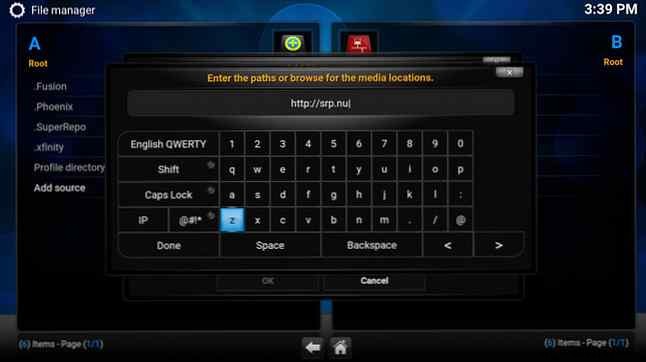
One of the most popular repositories is SuperRepo. Another is fusion. A quick Google search will get you much further.
Once you've added the URLs for these repositories, you'll want to install them. To do this, go to System> Plugins> Install from .zip , and select the repository you just added. This should be pretty intuitive, but if you need more guidance, search Google or YouTube for how to install these specific repositories. If it is installed successfully, you will notice a small pop-up window, which says “Plugin Enabled”. Huzzah!
If you want now, for example, to install some video plugins, click on Videos> Plugins> Get more . Then you'll see a huge list of plugins (thanks to those repositories).
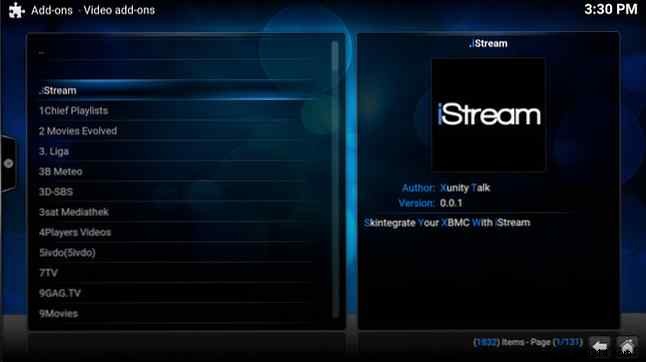
Select which ones you want to access on Kodi, then click Install . With these repositories installed, you'll be able to access just about any content you want (needless to say, we don't condone using Kodi for illegal content streaming).
Once you've installed a few addons, you'll want to customize how it interacts with Kodi. First things first, the Kodi home screen can sometimes look a bit clunky. Fortunately, there are a few settings you can change to make Kodi's default home screen work for you. If you have installed a new skin, your customization options will be different.
Go to System> Settings> Appearance> Appearance> Settings> Start Window Options .
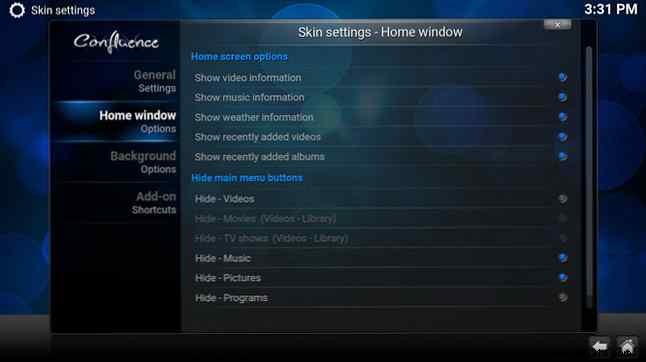
Here, you can choose exactly what is displayed on the default home screen. For example, if you never use Kodi for your images, you can choose to hide the “Images” menu. This can make your Kodi experience much easier.
If you find yourself constantly using the same add-ons on Kodi, you'll want these to be easily accessible from your home window. The fewer clicks to your desired content, the better, right?
Go to System> Settings> Appearance> Appearance> Settings> Plugin Shortcuts

When using the default Kodi skin, you can select up to five of your installed addons to add to each of the home screen menus (Pictures, Videos, Music, etc.). When you return to the home screen, you'll now see these additional shortcuts right there on your main menus. Combine this with some Kodi keyboard shortcuts. 50 Kodi Keyboard Shortcuts You Really Need To Know 50 Kodi Keyboard Shortcuts You Really Need To Know If you discovered Kodi you probably couldn't live without it now. However, if you are tired of controlling Kodi through a remote control app, you can use these keyboard shortcuts. Read More
If you get bored with Kodi's default background image, you can set it as you like.
Go to System> Settings> Appearance> Skin> Settings> Background Options .

Then select Enable custom background , click Background Path , and select the location of your image. The ideal size for this image is 1920 x 1080..
If you don't like the way Kodi displays your folders and media, this can be easily changed. When any media library is open, click the little arrow on the left side of the screen.

This opens a settings widget. Click the View Input to toggle the different views that are available.
If you want a screen saver to appear after a certain period of time, go to System> Settings> Appearance> Screen saver .
Click on Screen saver mode to select one of the default screen savers. These are pretty boring. One just blacks the screen, the other dims the screen, and the other plays ping pong on the screen.
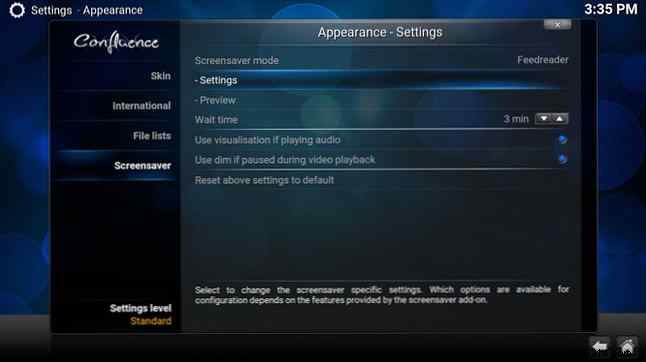
If you want something more interesting, click Get more and you'll have a decent range to choose from. These include digital clocks, a news feed, beautiful image slideshows, and more.
You also have the option to choose how long to wait before the screen saver kicks in. And you can even select whether you want the screen saver to activate when you're playing music in the background and/or when you pause a video.
Along the bottom of Kodi, you will see a scrolling RSS feed displaying Kodi news. Going to System> Settings> Appearance> Skin , You can choose to disable this feed or change it to one (or many) of your choice.
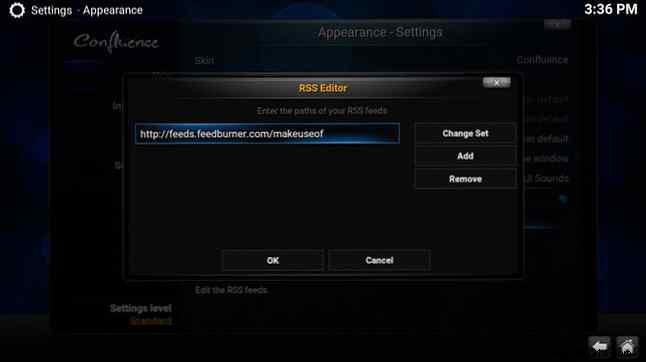
To add a custom RSS feed, under “Show RSS news feeds”, click Edit> Add and enter the URL of the feed you want to add. You can also choose to remove any of the fonts on that list. Enter as many feed URLs as you like. These will then fill that hover text on the home page.
Go to System> Settings> Weather> Service for weather information and select the source you trust the most for your forecasts. Then click Settings and choose your location.

To see this forecast on your home page, go to System> Settings> Appearance> Skin> Settings> Home window> Show weather information . Now you can easily access a localized weather forecast every time you open Kodi.
If you want to go even further in making Kodi look different than the default, you'll want to install a different skin. These are different layouts that other Kodi users have created, so you can choose the one you like best.
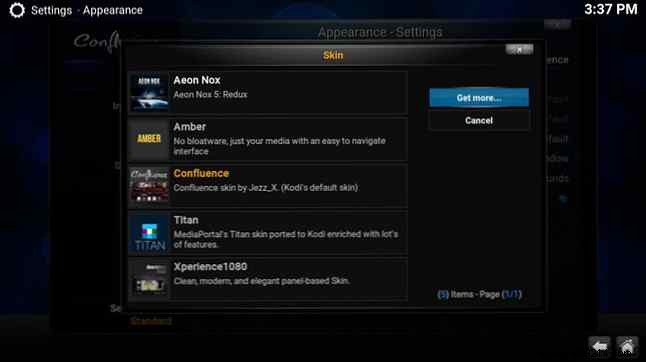
When you install a different skin, the available customization options will be different than when using the default Kodi skin. Custom menus you created earlier, for example, may not be visible. However, if you decide to go back to the default skin, your customizations will still be saved.
Go to System> Settings> Appearance> Skins> Skin> Get more
If you want to get away with all this, try the Titan skin. The customization options are almost endless..
On many skins, including Kodi's default skin, you will see a star at the bottom of the screen. This is where your favorites are saved. In other skins, your favorites may be saved in a different menu, but they work the same.
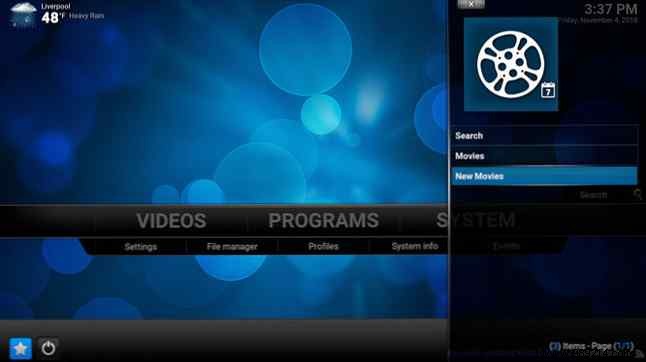
Favorites are particularly useful if you have a large number of plugins installed, with some that you want to be able to access extremely quickly.
When you go to the list of plugins for any category, right mouse button in your main plugins, and select Add to favorites . You can even add certain subcategories within plugins to your favorites. For example, if you use the Exodus plugin, you can save the Exodus search page to your favorites for quick access.
If you've spent time customizing Kodi, it's also helpful to copy the same customizations to other devices (including Raspberry Pi 3 Ways to Set Up Your Raspberry Pi as a Media Server 3 Ways to Set Up Your Raspberry Pi as a Media Server Which Media Center App should you install on your Raspberry Pi? Several options are offered, and now we'll walk you through them, looking at the features, pros, and cons of each (Read More). To do this, you must first backup your Kodi settings. The saved file can be used to clone the configuration to another device.
This process has been covered by various sites in the past, so there is little point in clarifying and repeating that information. You can find the exact steps here.
For many, getting started with Kodi can seem quite complicated. But once you've installed a few add-ons, and placed shortcuts where you need them most, Kodi can be a truly amazing media player. How To Make Your Kodi Media Center Even More Amazing How To Make Your Kodi Media Center Even More Amazing It's capable of much more than even its designers imagined. So, we dug deep and found out 10 fascinating ways to make your Kodi media center even better. Here are some awesome tips for Kodi fans... Read More .
Virtually any file type is supported. If you're a Netflix or Amazon Prime subscriber, there are even ways to access those libraries from within Kodi. If you pay for a UK TV license, you can add all those live streams to Kodi. Your options are virtually limitless (and sometimes overwhelming).
So spend some time organizing Kodi the way you like it. Once that's done, it must be the best media player I've ever had the pleasure of using.
How else have you customized Kodi to work for you? Did you use any of these tips to make Kodi even better than it already was? Please let us know your thoughts on Kodi in the comments below!